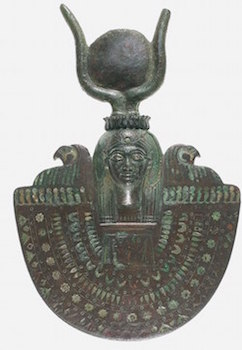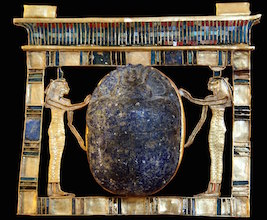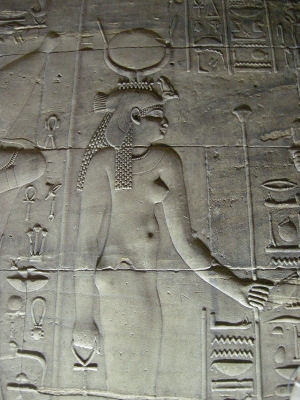
Isis was one of the oldest gods or goddesses of ancient Egypt but her origins are unclear. She is sometimes thought to have originated in the Sinai but is is also likely that she was first worshipped as a fetish in the Delta area of Lower Egypt around Busiris, the location of the oldest known cult center to Osiris. However, her cult was not limited to one area, but worshipped in every temple in the land. In fact, the first shrine dedicated specifically to her was built by Nectanebo II in Dynasty Thirty!
The cult of Isis, the Egyptian goddess, was very popular throughout Egypt, and beyond and she became a goddess of almost limitless attributes. Isis was her Greek name, but she was known to the ancient Egyptians as Aset (or Ast, Iset, Uset), which is usually translated as “(female) of throne” or “Queen of the throne”.
Her original headdress was an empty throne and as the personification of the throne she was an important source of the Pharaoh’s power (as descent was to some degree matrilineal). However, the exact meaning of her name is still disputed.

Plutarch suggested that her name meant “knowledge” but another possible translation is “(female) of flesh”, i.e. mortal, suggesting that although she was the Queen of the Gods, she had once been a mortal woman. This certainly fits with the mythology surrounding the Ennead which state that Isis and her husband, Osiris, had actually ruled Egypt before the time of the pharaohs.
The Book of the Dead describes her as “She who gives birth to heaven and earth, knows the orphan, knows the widow, seeks justice for the poor, and shelter for the weak” suggesting that she was considered to be more than simply a mere mortal. Isis was known as “Hent” (Queen) in every Nome, but she was also known by a bewildering number of names and titles throughout ancient Egypt and took on the aspects of many other goddesses. This resulted in a fairly complex relationship with the other gods and goddesses.

Isis was a member of the Heliopolitan Ennead, as the daughter of Geb (Earth) and Nut (Sky) and the sister and wife of Osiris and the sister of Set, Nephthys and (sometimes) Horus the Elder. However, because of her association with the throne, Isis was sometimes considered to be the wife of Horus the Elder, the patron of the living Pharaoh. Ra and Horus were closely associated during early Egyptian history, while Isis was closely associated with Hathor (who was described as the mother or the wife of Horus or Ra) and so Isis could also be considered to be the wife of Ra or Horus.
When Ra and Atum (the Ennead of Helipolis) merged, Isis became both the daughter of Atum(-Ra) and the wife of (Atum-)Ra. This situation was clarified by crediting Isis as the granddaughter of Ra-Atum, the mother of Horus (the child) and the wife of Osiris.


The adoption of the mythology of Heliopolis as the national religion promoted Osiris to the position of King of the Netherworld. However, this position was already held by Anubis. As a result, a myth developed that Nephthys became pregnant by Osiris and gave birth to Anubis. There are various versions of the tale, in some cases Osiris genuinely mistakes Nepthys for his wife Isis (the two were depicted as being very similar in appearance), in other cases Nephthys intentionally tricks Osiris. Either way, Isis adopted her husband’s illegitimate child to protect her sister and the child from the rage of her brother Set and apparently was happy to forgive the adultery.
The Egyptians highly valued family life and Isis was the paragon of motherly virtues. From the New Kingdom, Isis was considered to be the archetypal mother and was a patron goddess of childbirth and motherhood. As Horus was the patron of the living Pharaoh, Isis could be described as the mother of the Pharaoh.
The image of Isis and the infant Horus was extremely popular in Egyptian art and it is generally accepted that they had a huge influence on the iconography of Mary and the infant Jesus Christ in the early Christian Church. However, while Mary is perhaps best described as a passive vessel who was not considered to have any power independent of her child, Isis was not only a mother, but a confident and skilled queen and a very powerful sorceress.
Isis knew the secret name of Ra, which gave her an incredible amount of power. The Pyramid Texts imply that Isis prophesied the murder of Osiris (although she was unable to prevent it) and her power even extended beyond the grave. At her insistence Anubis and Thoth devised the first ritual of mummification to give Osiris life after death and she herself managed to magically conceive her son Horus by hovering over the body of her dead husband.
She was one of the four protector goddesses (along with Bast, Nephthys, and Hathor, or Nephthys, Selket, and Neith) who protected the sarcophagus and the Canopic jars (which contained the internal organs). It was thought that she helped the deceased on their difficult journey into the afterlife and she was sometimes named as one of the judges of the dead.


Her priestesses were skilled healers and midwives, and were rumoured to have magical powers. Like the priestesses of Hathor they could interpret dreams, but they were also thought to be able to control the weather by braiding or combing their hair (a superstition which was common in many later seafaring cultures).
During the Ptolemaic period she was linked with Astarte as the patron goddess of sailors as it was hoped that she would provide a favourable wind. Her loyalty to her murdered husband and infant child, her courage in defying Set, and her warmth and compassion towards all people (even Set) made Isis one of the most beloved goddesses in Egypt, and indeed the ancient world.

Isis was often represented as a goddess wearing a headdress representing a throne (which was one of the hieroglyphs in her name). She was also frequently depicted as a human queen wearing the vulture headdress with a royal serpent on the brow. In these two forms she occasionally carried a lotus bud or the glyph of the sycamore tree.
She was also commonly depicted as a queen or goddess wearing the double crown of Upper and Lower Egypt along with the feather of Ma’at. There are also numerous representations of Isis with her son, Horus.
Isis was also depicted as a winged goddess or a kite (one of her sacred animals). In this form her wings spread a heavenly scent across the land and brought fresh air into the underworld. From the New Kingdom she also adopted the vulture headdress with cow’s horns on either side of a sun disk between them. Occasionally she was depicted as a cow or a woman with a cow’s head. In her form of the snake goddess Thermouthis she was depicted as a cobra crowned with the throne headdress.
The Tjet amulet was also known as the “Knot of Isis”, “Buckle of Isis”, or the “Blood of Isis”. Although the meaning of the Tjet is fairly obscure, it is thought that it may have represented a woman’s sanitary cloth (hence the connection with blood) or may relate to the magical power in a knot (again linking it with Isis the great magician). The Tjet was used in the funerary rites and seems to have been linked with the ideas of resurrection and rebirth.
She was sometimes paired with Khnum in representing Upper Egypt, just as Ptah-Tanen was associated with Nephthys in representing Lower Egypt.
- Goddesses associated with Isis
- Isis, Osiris and Horus
- Isis and the Seven Scorpions
- Isis and Ra
- Temple of Isis, Philae
Bibliography
- Bard, Kathryn (2008) An introduction to the Archaeology of Ancient Egypt
- Goodenough, Simon (1997) Egyptian Mythology
- Grajetzki, W (2003) Burial Customs in Ancient Egypt
- Kemp, Barry J (1991) Ancient Egypt: Anatomy of a Civilisation
- Lesko, Barbara S (1999) The great goddesses of Egypt
- Pinch, Geraldine (2002) Handbook Egyptian Mythology
- Redford Donald B (2002) Ancient Gods Speak
- Watterson, Barbara (1996) Gods of Ancient Egypt
- Wilkinson, Richard H. (2003) The Complete Gods and Goddesses of Ancient Egypt
- Wilkinson, Richard H. (2000) The Complete Temples of Ancient Egypt
Copyright J Hill 2008